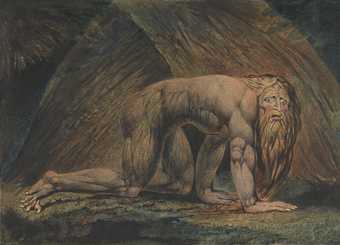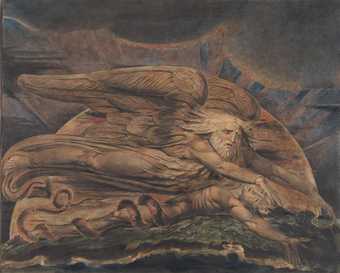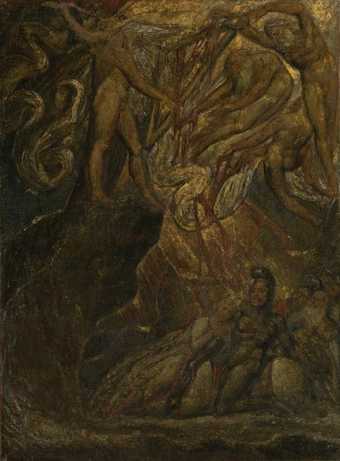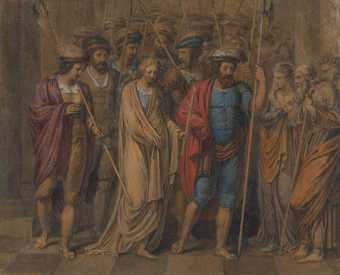Blake’s exhibition, held above his brother’s hosiery shop in Broad Street, near Golden Square in Soho, London, was a turning point in his career. 1 Although relatively modest in scale, containing just sixteen works, it was a courageous act of self-assertion, intended to promote Blake as an artist, a painter worthy of grand public schemes rather than, as he was usually known if at all, as an engraver and writer with eccentric tendencies. Blake published a Descriptive Catalogue to accompany the exhibition, which was as much a manifesto as an explanation of his ‘Poetical and Historical Inventions’, which he said were drawings or ‘Water Colours … the Ancient Method of Fresco Painting Restored’.2 In his advertisement for the exhibition, Blake had cited the prejudice of the Royal Academy against watercolour as a reason for showing his work privately. Feeling himself ‘effectually excluded’ from the Academy, he found it ‘necessary that I should exhibit to the Public, in an Exhibition of my own’.3
In fact, Blake could by then have taken his pick of two exhibiting societies of watercolourists, the Society of Painters in Water-colours founded in 1804 and the New Society, or Associated Artists established in 1807. 4 But not only were Blake’s technical processes, which included tempera, far broader than the definition of watercolour usually assumed, as his term ‘Fresco’ implies, he must also have objected on principle to the predominance of and preference for landscape subjects in these contemporary watercolour exhibitions. His intention instead, both technically and conceptually, was to return to ‘the Grand style of art’, which in his interpretation was as far from the Reynoldsian definition promoted by the Academy as it was from the highly worked ‘exhibition watercolours’ now appearing in dedicated shows.
Just as Blake claimed a mythic origin for his method of ‘water colours’, so his ‘Grand style’ sought to reconnect with his visionary and prophetic concept of history more than to engage with conventional understandings of history painting or trends in the history of art. While the exhibition included a subject taken from the poet conventionally considered to be the exemplar of the Sublime, in the form of Satan Calling up his Legions (Victoria and Albert Museum, London) based on Milton, the catalogue described this work ironically, as a failed experiment in ‘that infernal machine, called Chiaro Oscuro’ painted under the influence of ‘Venetian and Flemish Demons’.5 The last work in the catalogue, The Penance of Jane Shore in St Paul’s Church (Tate), might at first appear a more conventional watercolour of a scene from the national past. It dated from earlier in Blake’s career and he used it to emphasise the imaginative continuity linking ‘the productions of our youth and of our maturer age’.6 But in her paper published in this issue of Tate Papers, Susan Matthews probes the unspoken messages, political, historical, moral and aesthetic, that Blake may have hoped to convey by its resurrection.
In his preface to his catalogue, Blake sought to purge art of the false colourists from Titian to Rembrandt and the misguided ‘Connoisseurs’ whose ‘eyes of stupid cunning’ held such artists in thrall. Instead, he upheld a modern version of a primitive style, rooted in ‘Form or Outline’ and the imagination of ‘self-devoting genius’. 7 His historical subjects are released from time, and even space, into a characteristically Blakean continuum. Chaucer’s Canterbury pilgrims, whom Blake had painted in one of the key compositions included in the 1809 show (now Pollok House, Glasgow) are described as characters ‘from all ages and nations … lineaments of universal human life’ 8 the ‘spiritual forms’ of Pitt and Nelson (highly dubious objects of national veneration in Blake’s view) are based on ancient types seen in visions by the artist, who has applied their grandeur to ‘modern Heroes, on a smaller scale’ 9 Gray’s Welsh bard is at once the last of his line and a prophet of his destroyer’s nemesis. The subjects of Blake’s largest (and lost) exhibit, the three ancient Britons who escaped alive from King Arthur’s last battle, empower his conviction that the ‘British Antiquities are now in the Artist’s hands; all his visionary contemplations, relating to his own country and its ancient glory, when it was and as it again shall be, the source of learning and inspiration’.10
However eccentric or high-flown Blake’s way of putting it, his case belonged to its own, real time, and is recognisable in other voices from the period. Blake was not just trying to give his own reputation a lift, but pressing for public support and patronage for art of national significance, a cause that had exercised generations of British artists. Of a group of watercolours of biblical subjects in the exhibition, he expressed his wish that they were ‘on an enlarged scale to ornament the altars of churches, to make England like Italy’.11
Other artists were arguing for the same, and Blake soon fell into the tragic pattern in which those with the grandest claims, from James Barry to Benjamin Robert Haydon, were often the most isolated and self-defeating. In retrospect, Blake’s exhibition has been best known for being such a spectacular flop. There were very few documented visitors and only one published review, by Robert Hunt in The Examiner (17 September 1809) – a review so cruel and insulting that it would surely be actionable today.12 Far from winning a wider reputation for himself and redeeming the national taste, Blake became more withdrawn than ever. But even this he had foreseen; he concluded his catalogue with the defiant statement that he knew he was master of his art, and ‘if he is not employed … he will employ himself’.13
If the failure of Blake’s venture has tended to emphasise Blake’s isolation and exceptionalism, the articles gathered in Tate Papers, issue 14 do much to reconnect him with his contemporaries and with London’s burgeoning culture of exhibitions, displays and related publications. Susan Matthews finds Blake haunted by the melancholy ghost of Barry, who had died just three years before, not only in his championship of Wollstonecraft but also in the echoes in the Descriptive Catalogue of Barry’s self-promoting account of his pictures in the catalogue of the Society of Arts 1783. For Konstantinos Stefanis, Blake’s exhibition stands as an early example of an artist’s retrospective, presented as an ensemble and a vehicle for his creative credo. For Philippa Simpson, the catalogue, along with his conditions of sale and methods of display, shows Blake’s debt to the many exhibitions and sales of Old Master paintings taking place in London in the aftermath of the French Revolution. While Blake’s strategic debt should not imply unqualified admiration of the works themselves, these displays, vigorously promoted for sale to collectors or even as the basis for the national collection still lacking in Britain, had become regular highlights of what Simpson describes as ‘the capital’s new exhibitionary battle-field’.14
Both artists’ retrospectives, and Old Master exhibitions, were relatively new to London. As examples of the former, Stefanis cites especially the commemorative exhibition of Joshua Reynolds held by the British Institution in 1813. However, the Institution actively encouraged a relationship between old and new art, exhibiting modern British artists and presenting loan exhibitions of Old Masters owned by its predominantly aristocratic directors and sponsors.15 That its catalogues promoted their taste and influence, as well as sometimes puffing pictures in their collections, was well-known and in 1815 and 1816 these would be ruthlessly mocked in spoof ‘catalogues raisonnées’. Artists were generally wary of the Institution’s motives, not least in promoting pictures designed as companions for Old Masters, and even one as much admired in Institution circles and a star of the Royal Academy as David Wilkie would attempt an exhibition of his own. Wilkie’s, in 1812, took place in rooms immediately opposite the Institution’s premises in Pall Mall, and was a retrospective of his still emerging talent. He lost money on it, but gained prestige.16
Wilkie’s much vaunted original style was in fact politely deferential to the Dutch and Flemish Old Masters that were admired by his patrons but anathema to Blake. The influence of the Old Masters was also strongly felt in the pictures shown by J.M.W. Turner at his gallery in Harley Street since 1804. Turner’s Gallery is in many respects the most striking contemporary example of an artist taking the promotion of his work into his own hands, at a time when commercial dealers and galleries were unknown.17 Turner’s exhibition in 1809 is the obvious and best documented comparison with Blake’s, but also a misleading one. At first glance, it was everything Blake’s was not – popular, well attended and reviewed. Yet here, too, buyers were comparatively few, and belonged to Turner’s existing circle of aristocratic patrons. On the other hand, Blake, for all his insistence on ‘conditions of sale’ and that works should not be removed by purchasers during the exhibition, showed some works borrowed from their owners, and so was not without clients of his own.
What does link exhibitions like Wilkie’s, Turner’s and Blake’s, initiated and installed to show their strengths, or emphasise themes and narratives within their work, was a degree of curation that was quite impossible in mixed, committee-hung exhibitions at the Royal Academy or the watercolour societies, or those at the British Institution arranged by elite collectors. As Simpson observes, this was evident in Blake’s hang, and probably reflected in the numbering of the catalogue. And just as Blake highlighted the historical and national, as well as biblical strands in his work and included a spectacular centrepiece in the form of his huge Ancient Britons, so Turner wove English landscapes and pastoral, poetic subjects focused on the River Thames into a lyric, patriotic story around his own big focal point, Thomson’s Aeolian Harp (Manchester Art Gallery). Moreover, Turner’s Gallery went on to demonstrate the creative continuity that Blake had claimed in respect of his Jane Shore. Increasingly the home for unsold pictures from earlier years as well as a showcase for new work, its retrospective role grew; from a vibrant commercial space it turned into a museum, and, finally, the mausoleum where Turner’s body lay in state in 1851. Throughout, the painter had insisted that his work be kept, and understood, together.
In honouring the styles of Old Masters and the classical literary tradition, Turner’s Gallery amounted to a surrogate of the National Gallery to which he hoped it would accrue after his death; it was a retrospective of his cultural history as well as of his art. As such, it was unique in scope but not necessarily in inspiration or intent. The interpretation of national and cultural history in Blake’s exhibition and catalogue was radical, revisionist and entirely his own. Yet in the papers given here, his project is seen to emerge from the same pre-history of London’s long-awaited public gallery, from the calls for a national collection issued by radical friends like William Godwin to the succession of exhibitions, sales and promotions of Old Masters that might have furnished its contents. Blake’s sense of creative renewal after seeing the Truchsessian Gallery, on display between 1804 and 1806, was perhaps overdone; Count Truchsess had over-hyped his pictures in the hope of selling to the nation by subscription.18 Yet as Simpson observes, the installation and marketing of such collections was an inspiration in itself, to add to that of the emerging retrospective discussed by Stefanis. For Matthews, the failure to secure the Count’s pictures for the nation – only the most recent in a series of missed opportunities – was a spur for Blake’s exhibition to assume its own status as an ‘alternative national gallery’.
Two hundred years after Blake’s exhibition closed, it may be hard to imagine that the chance to see a gathering of his works curated by the artist himself could have been so completely overlooked and misunderstood. Today, Blake is among the best loved and most internationally famous of historic British artists, and his images and poetry have been the focus of extraordinary scholarly efforts. The mainstream of Blake studies has, arguably, been dominated by literary scholars who have generally focused on a core of canonical texts (namely, the great prophetic books of the 1790s, together with Milton, 1804–10 and Jerusalem, completed 1820). With some very notable exceptions, Blake’s visual art, certainly the paintings and watercolours, has been relatively neglected, often because he is assumed to be an exceptional figure, who worked in isolation from and necessarily in conflict with the wider world.19 The three papers brought together here provide a different view of Blake, by looking at the 1809 show as an attempt on the part of the artist to insert himself into art history, and by providing such a rich sense of Blake’s possible motivations and the broader context of the exhibition itself. Together, they suggest both how well positioned we are to understand Blake’s art in its historical setting, but also how much more there may still be to explore about the significance of his output as a painter.




